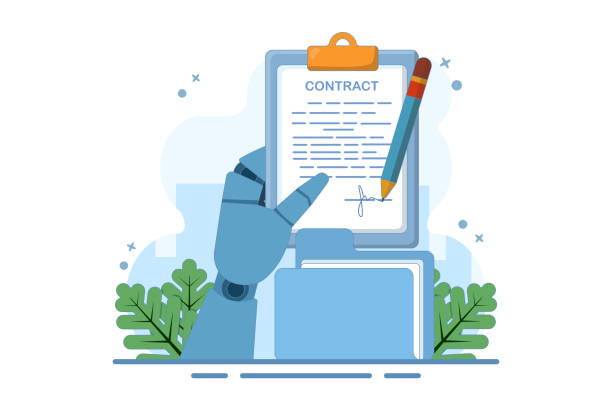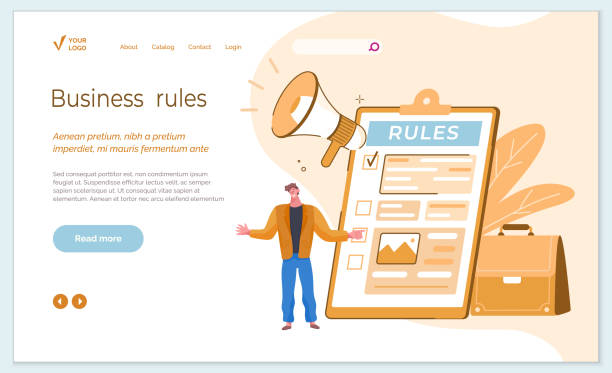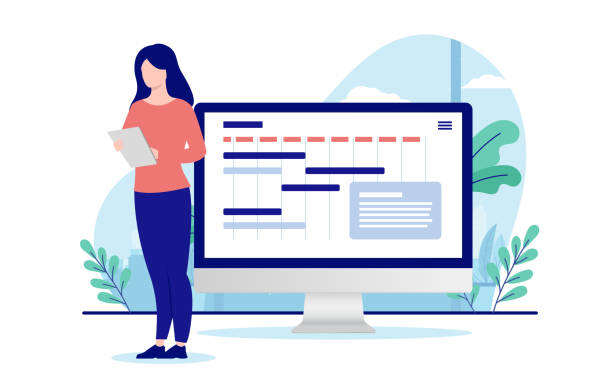Introduction to the Importance of Multilingual Website Design

In today’s world, geographical boundaries mean less for businesses, and #Globalization and access to the #InternationalMarket are considered necessities for survival and growth.
In this context, having a multilingual website design is no longer a competitive advantage; it’s a requirement.
If you’re looking to expand your market beyond domestic borders, your website must be able to communicate with audiences from all over the world.
This explanatory section shows you why investing in web design for multilingual sites is a smart and strategic step for any brand.
International audiences often prefer to engage with content in their native language.
This not only helps them better understand your message but also builds a greater sense of trust and closeness between you and the user.
Statistics show that most internet users prefer to make their online purchases in their native language, even if they are fluent in another.
This is an important educational point that should not be overlooked.
Furthermore, a multilingual website design helps you achieve a good ranking in local search engines in different countries, which leads to increased organic traffic and, consequently, more potential customers.
Ignoring this issue can deprive you of significant growth opportunities and allow competitors to overtake you in international markets.
Therefore, this is not just a technical decision, but a strategic one for the future of your business.
Are visitors abandoning your e-commerce site before making a purchase? Worry no more! With RasaWeb’s professional e-commerce website design services, solve the problem of not converting visitors into customers forever!
✅ Significant increase in conversion rates and sales
✅ Unparalleled and engaging user experience
⚡ Contact us now for a free consultation!
Challenges and Solutions for Implementing Multilingual Website Design

Implementing a multilingual website design comes with its own specific challenges, ignoring which can lead to project failure.
One of the main challenges is managing translated content and ensuring its accuracy and quality.
Translation is not just about words; concepts, tone, and the culture of the target language must also be considered.
This guidance and specialized section explores these challenges and provides practical solutions to overcome them.
Another challenge involves issues related to multilingual SEO.
How should search engines determine which version of your content is suitable for which language? Using hreflang tags, appropriate URL structures, and multilingual sitemaps are solutions that help resolve this issue.
Also, during multilingual website design, you may encounter problems with fonts, text direction (right-to-left or left-to-right), and date and time formats, which require careful attention from developers.
Content Management Systems (CMS) like WordPress with multilingual plugins or Drupal, which natively support multilingualism, can significantly simplify the process.
Solutions include hiring native translators, using Translation Management Systems (TMS), and leveraging multilingual SEO specialists, which are among the most important actions to consider.
Choosing the Best Strategy for Multilingual Website Design

To implement a multilingual website design, there are different strategies, each with its own advantages and disadvantages.
Choosing the right strategy depends on various factors, including your business type, content volume, budget, and SEO goals.
In this analytical and specialized section, we will examine three main approaches: using subdomains (e.g., en.yoursite.com), subdirectories (e.g., yoursite.com/en/), and URL parameters (e.g., yoursite.com?lang=en).
Subdomains: Each language is placed on a separate subdomain.
This method can be beneficial for SEO because search engines recognize each subdomain as a separate site with its own domain authority, but it may require separate management for each subdomain.
Subdirectories: Different languages are placed as subdirectories within your main domain.
This method is very popular for SEO because it transfers the main domain’s authority to all languages, and its management is relatively simpler.
Most search engines prefer this structure.
URL Parameters: Language is specified through URL parameters.
This method has the least technical complexity, but in terms of SEO, search engines may consider it less optimized, and crawling and indexing it might be more difficult.
Choosing the correct approach is the cornerstone of a successful multilingual website design.
Below is a comparative table for better understanding:
| Feature | Subdomain | Subdirectory | URL Parameter |
|---|---|---|---|
| SEO Score | Medium to Good | Excellent | Weak |
| Ease of Implementation | Medium | Good | Excellent |
| Hosting Management | More | Less | Least |
The final choice should be made in consultation with SEO specialists and web developers to achieve the best results for your multilingual website design.
SEO Optimization for Multilingual Website Design

After choosing the appropriate structure, SEO optimization for a multilingual website design is one of the most vital steps for success in global markets.
Without a strong SEO strategy, even the best content will not be seen.
This specialized and guidance section helps you optimize your site for search engines in different languages.
One of the most important techniques is the correct use of the hreflang tag.
This tag tells search engines like Google which version of the page is intended for which language and geographical region.
This prevents the creation of duplicate content and helps direct users to the correct language version.
Also, keywords should be researched and optimized separately for each language.
Direct translation of keywords is often not effective, as they may not have the same meaning or search volume in another language.
Furthermore, you must ensure that all website content, including text, images, videos, and even metadata such as page titles and descriptions, are correctly translated and localized.
Website loading speed also gains additional importance in multilingual SEO, as audiences from distant geographical locations may experience greater delays.
Using a CDN (Content Delivery Network) can help reduce this delay.
Finally, internal and external link building for each language version should also be considered to strengthen domain authority for all languages.
Are you tired of your company’s website not meeting your expectations? With RasaWeb, design a professional website that truly represents your business and attracts more customers.
✅ Build a powerful and professional image for your brand
✅ Convert visitors into real customers
⚡ Get a free website design consultation now!
Content and Translation Management in Multilingual Website Design

Content management and the translation process are an inseparable and perhaps the most complex part of multilingual website design.
A robust system for multilingual content management not only reduces time and cost but also helps maintain the quality and consistency of your brand across different languages.
This guidance and explanatory section discusses efficient tools and processes in this area.
The first step is choosing a Content Management System (CMS) that natively supports multilingualism or provides the necessary functionalities through plugins.
Systems like Drupal and Joomla are strong in this regard, and WordPress also offers good features with plugins like WPML and Polylang.
After selecting the CMS, it’s time to establish an efficient translation process.
This process can include hiring in-house translators, outsourcing to professional translation agencies, or using a combination of machine translation and human review.
Translation Management Systems (TMS) can help automate parts of the process, manage Translation Memories (TM) and Glossaries to maintain terminology consistency and reduce costs.
Additionally, you should have a regular plan to update translated content simultaneously with the original content.
This prevents outdated or inconsistent information in different language versions and preserves the credibility of your multilingual website design.
The Role of User Experience (UX) in Multilingual Website Design

User Experience (UX) in multilingual website design becomes even more critical because you are dealing with diverse audiences with different cultural and linguistic backgrounds.
Good UX not only allows users to easily access the information they need but also strengthens their sense of satisfaction and trust.
This educational and specialized section covers the importance and details of UX in this area.
The first point is to design a user interface that easily allows language switching.
This option should be placed in a clear and accessible location (e.g., header or footer) and use universally recognized symbols such as country flags (with caution) or language codes (e.g., EN, FA).
It should also be noted that some languages (like Persian and Arabic) are written from right to left, while many others (like English) are from left to right.
Your Responsive Design should be capable of adjusting page layout based on text direction.
Furthermore, visual elements, colors, and symbols may have different meanings in various cultures.
An image that is completely harmless in one culture might be considered offensive in another.
Therefore, localizing visual content is as important as text.
Finally, page loading speed and overall site performance for users worldwide must be optimized to ensure a positive user experience.
These subtle points make a big difference in the success of your multilingual website design.
Technical and Infrastructure Aspects in Multilingual Website Design

Behind every successful multilingual website design lies a strong and optimized technical infrastructure.
Ignoring technical aspects can lead to performance, security, and SEO issues that severely impact user experience.
This specialized and explanatory section addresses the most important technical and infrastructural considerations in this area.
Choosing appropriate hosting is a key factor.
For multilingual sites with a global audience, using geographically dispersed servers or leveraging a Content Delivery Network (CDN) is essential.
A CDN significantly increases loading speed by caching your site’s content on servers close to users worldwide.
Database management is also important.
The database must be able to store various characters and alphabets (such as UTF-8 Unicode) to display content correctly for all languages.
The URL structure for each language must also be technically implemented correctly, as mentioned in previous sections.
Multilingual site security should not be overlooked either.
SSL/TLS certificates are essential for all domains and subdomains.
Regular and scheduled backups of the database and files, especially for sites with large amounts of content and multiple languages, are critical.
Below, some important technical and infrastructural considerations for multilingual website design and their respective solutions are provided:
| Technical Consideration | Importance | Solution |
|---|---|---|
| Hosting and Server | High | Choosing hosting with global coverage or CDN |
| Database | High | Unicode (UTF-8) support |
| Security (SSL) | Very High | SSL/TLS certificate for all versions |
| Backup | High | Regular and automatic backup |
These technical aspects are the foundation for the success of a stable and efficient multilingual website design.
The Future of Multilingual Website Design and New Trends

The digital world is rapidly evolving, and multilingual website design is no exception.
New trends and emerging technologies are shaping the future of this field and creating unprecedented opportunities to connect with global audiences.
This news-oriented and thought-provoking content section examines these trends.
One of the most significant advancements is the development of Artificial Intelligence (AI) and Machine Learning in translation.
Neural Machine Translation (NMT) has reached astonishing accuracy in recent years, which can make the content translation process faster and more cost-effective.
Will human translators be replaced by AI in the near future? This question still has no definitive answer, but their role will certainly change.
Another trend is the increased focus on localization beyond translation.
This means fully adapting content to the culture, values, and even humor of a specific region.
This approach creates a deeper connection with the audience and significantly enhances the user experience.
Additionally, with the growth of voice search and smart assistants, optimizing multilingual websites to respond to voice queries in different languages is becoming increasingly important.
This requires understanding the linguistic nuances and tone in various languages.
The future of multilingual website design is moving towards greater personalization and an exceptional user experience, where content is delivered to each user not only in the correct language but also with the appropriate tone and culture.
Is your company’s website as professional and trustworthy as it should be? With RasaWeb’s specialized corporate website design, create an online presence that reflects your credibility and attracts more customers.
✅ Build a powerful and professional image for your brand
✅ Convert visitors into real customers
⚡ Get a free consultation now!
Successful Case Studies in Multilingual Website Design

Reviewing real and successful examples of multilingual website design can be inspiring and provide valuable practical insights.
This engaging and analytical section looks at several case studies of companies that have performed well in developing their multilingual websites and have successfully penetrated global markets.
One prominent example is the Airbnb website.
This accommodation platform covers dozens of languages and thousands of regions, providing a seamless user experience for users worldwide.
They not only translate content but also pay special attention to full localization, including currencies, units of measurement, and even search features based on different cultures.
Another example is the IKEA website.
This Swedish furniture company, with separate websites for each country, not only adapts the language but also adjusts its products and marketing campaigns based on the local needs of each market.
This approach has allowed them to succeed in highly diverse markets, from Europe to Asia and America.
The key lesson from these examples is that multilingual website design is not just about adding a few languages to a site, but a comprehensive strategy for understanding and serving global audiences.
This includes in-depth market research, precise localization, and continuous optimization based on user feedback.
The success of these companies shows that with proper planning and execution, any business can achieve global growth and expansion with a powerful multilingual website design.
Conclusion and Next Steps in Multilingual Website Design

Throughout this article, we’ve explored various dimensions of multilingual website design; from its strategic importance and implementation challenges to technical aspects, SEO, content management, and user experience.
It is clear that having a multilingual website is no longer an option but a necessity for any business aiming to enter and compete in global markets.
This guidance and explanatory section summarizes the key points and outlines the next steps for you.
Key Takeaways:
- Strategic Importance: Multilingual website design is a gateway to global markets and increases access to international audiences.
- Detailed Planning: Choosing the right URL structure and efficient translation strategy are among the first steps.
- Multilingual SEO: Using the
hreflangtag, local keyword research, and metadata optimization are crucial. - Content Management: Using a suitable CMS and professional translation processes are essential for maintaining quality.
- User Experience (UX): Localizing the UI and UX for each culture is the key to success.
- Technical Infrastructure: Hosting, CDN, and security are important considerations.
Next Steps:
- Market Research: Before any action, identify your target audience and required languages.
- Consult with Experts: Consult with web developers, SEO specialists, and professional translators.
- Choose the Right Tools: Select a CMS and Translation Management System (TMS) appropriate for your needs.
- Start with One Language: You don’t need to implement all languages simultaneously; start with one or two important languages and gradually expand.
- Measure and Optimize: Monitor site performance in different languages and make necessary improvements based on data.
Multilingual website design is a long-term investment that, with proper planning and precise execution, can bring extraordinary returns for your business and pave the way for international success.
Frequently Asked Questions
| Question | Answer |
|---|---|
| What is a multilingual website? | A website whose content is available to users in more than one language. |
| Why should I make my website multilingual? | To reach more audiences in global markets, improve user experience, and enhance international SEO. |
| What are the technical approaches to building a multilingual website? | Using subdirectories, subdomains, or URL parameters to separate languages. |
| How does multilingual design affect SEO? | By targeting local keywords and providing content in users’ native languages, the site’s ranking in search engines for those regions improves. |
| What are the challenges of multilingual website design? | Content translation management, Right-to-Left (RTL) direction support, technical issues related to language addressing, and maintaining design consistency. |
| How do we choose languages for a multilingual website? | Based on target audience analysis, target markets, and current website traffic data (if available). |
| What is RTL support and why is it important for some languages? | Right-to-Left is the direction of text and page elements display from right to left, which is essential for languages like Persian, Arabic, and Hebrew. |
| How do we manage multilingual website content? | Using multilingual Content Management Systems (CMS), translation plugins, or professional translation services. |
| How is the User Experience (UX) in a multilingual website? | The option to change languages should be easily available, and translated content should be of high quality to make users feel comfortable. |
| What are the common CMS platforms for multilingual websites? | WordPress (with plugins like WPML), Joomla, Drupal, and Shopify (with relevant settings or plugins). |
And other services of RasaWeb advertising agency in the field of advertising
Smart UI/UX: A combination of creativity and technology to increase click-through rates through precise audience targeting.
Smart Content Strategy: Designed for businesses looking to increase sales through attractive UI design.
Smart Marketplace: A new service for increasing customer behavior analysis through the use of real data.
Smart Advertising Campaign: Designed for businesses looking to attract customers through intelligent data analysis.
Smart Data Analysis: Revolutionize SEO ranking with marketing automation.
And over hundreds of other services in the field of internet advertising, advertising consultation, and organizational solutions
Online Advertising | Advertising Strategy | Advertorial
Resources
Multilingual Website Design Tutorial
SEO Principles in Multilingual Websites
Benefits of Having a Multilingual Website
Best WordPress Plugins for Multilingual Websites
? For your business’s leap in the digital space, RasaWeb Digital Marketing Agency paves your path to success with services such as custom website design, Search Engine Optimization (SEO), and professional social media management.
📍 Tehran, Mirdamad Street, next to Bank Markazi, Southern Kazeroon Alley, Ramin Alley, No. 6



